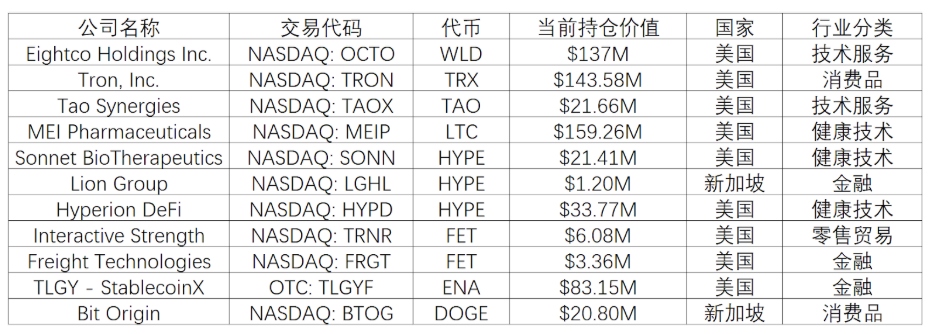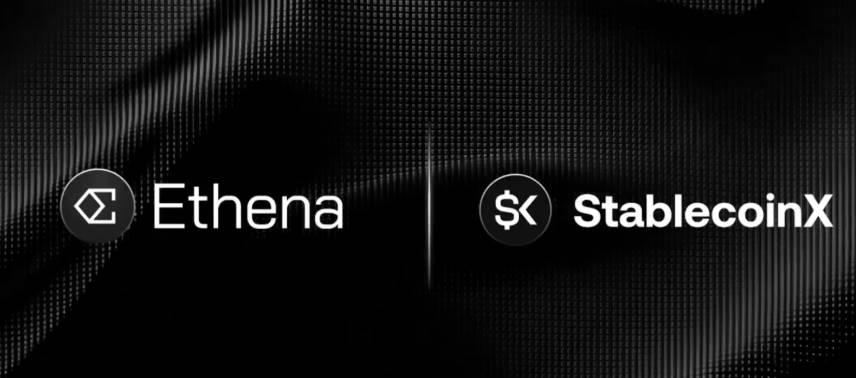This round of treasury allocation marks the convergence of three important trends.
Written by: 0xResearcher
If the market is a thermometer of emotions, then "treasury allocation" is the voting mechanism of enterprises. Who writes real money into their balance sheets and bets on which altcoins is often more reliable than the buzz on social media. In 2025, we see more and more publicly listed companies incorporating non-BTC and non-ETH tokens into their treasuries, such as FET and TAO in the AI sector, HYPE and ENA in new DeFi infrastructure, and veteran payment tokens like LTC and TRX, and even community-driven DOGE. Behind these holdings are not only business synergies but also demands for asset diversification, providing ordinary investors with a window to "see the direction": who is buying, why they are buying, and how they plan to use it afterward. Starting from these questions, it becomes easier to distinguish between strong narratives and weak narratives, and to understand which altcoins are being taken seriously by "institutional funds."
Why focus on treasury allocation?
Using "real money from enterprises" to identify strong narratives. First, because it is harder to fake. Once a company writes a token into its financial reports or regulatory documents, it means the management must explain the scale of holdings, accounting policies, custody, and risks, which is more binding than just "sloganeering." Second, because it is closer to "use and hold." In this wave of treasury allocations, many companies are not just buying tokens; they are also signing technical cooperation agreements and introducing tokens for product use or on-chain staking returns. For example, Interactive Strength plans to purchase approximately $55 million in FET and sign a partnership with fetch.ai, Freight Technologies binds FET with logistics optimization scenarios, Hyperion DeFi uses HYPE for staking and connects revenue and collateral paths with Kinetiq, and TLGY (planned to merge with StablecoinX) aims to establish an ENA treasury betting on Ethena's synthetic stability and yield structure. The commonality of these actions is that tokens are not just prices but also "certificates" and "fuel." Third, it provides ordinary investors with another path. You can directly study the tokens or gain "indirect exposure" by researching the publicly listed companies holding these tokens. Of course, this is a double-edged sword: small-cap companies combined with high-volatility tokens often see their stock prices act as "token proxies," with more extreme fluctuations. If you choose the "indirect exposure through stocks" route, position control and timing become particularly important.
From the market context of 2025, this trend is accelerating. Macroeconomically, the launch of spot crypto ETFs in the U.S. has increased risk appetite, and the strength of BTC and ETH has provided altcoins with an "exposure window" from point to surface, gaining more attention for quality sectors. The attitude of companies is also changing: from a few years ago's "tentative holdings" to "strategic allocations," and even the emergence of a new species of "crypto treasury as a main business"—some companies are actively transforming, clearly making the construction and operation of crypto treasuries their main line of business. In terms of disclosure, companies are no longer satisfied with press releases but are increasingly using regulatory documents, quarterly reports, and investor presentations to disclose holding sizes, fair values, custody details, and risk control arrangements, enhancing the verifiability of information. In short, the heat is back, the paths are clearer, and funds are starting to be more "serious." This also means that observing treasury dynamics is becoming a reliable window for understanding industry direction.

Recent statistics on treasury altcoin holdings of listed companies
Three main altcoin lines: AI, new DeFi, and veteran payment tokens
AI sector (FET, TAO): The key signal of this main line is "use and hold." Tokens from native AI networks are often not merely speculative targets but serve as "tickets and fuel" for access and settlement: the invocation of intelligent agents, access to computing power and model markets, and network incentive mechanisms all require the endogenous use of tokens. The entry of corporate treasuries often accompanies technical cooperation and business integration, forming a closed loop in logistics optimization, computing power invocation, or the implementation of intelligent agents, thus the speculative weight is relatively low, leaning more towards strategic allocation. However, this sector also has uncertainties: the combination of AI and blockchain is still in the validation stage, valuations may reflect future expectations prematurely, and the long-term sustainability of token economics (inflation/deflation mechanisms, incentive models, cost recovery) still needs observation.
New DeFi infrastructure (HYPE, ENA): This sector employs a combination of "efficiency + yield." HYPE represents performance-oriented DeFi infrastructure: it supports derivative trading and staking derivatives through high-performance chains, forming a funding cycle of "earning yields + liquid staking and re-staking," providing efficient utilization paths for institutions and liquidity pools. The interest of corporate treasuries lies in that it can bring on-chain governance and yields while enhancing liquidity and market stickiness through funding cycles.
ENA's appeal is more concentrated on the design of synthetic stability and hedging yields. Ethena attempts to create "dollar-like" stable assets and generate endogenous sources of income without relying on traditional banking systems by combining staking derivatives and hedging strategies. If this model can connect with exchanges, custodians, and payment endpoints, it could form a truly closed-loop "crypto dollar + yield" system. For corporate treasuries, this means they can hold stable accounting units while also obtaining tools for yield and hedging volatility. However, the risks are also more complex: clearing safety, the robustness of smart contracts, and stability under extreme market conditions are all key points requiring high-intensity auditing and risk control.

Source: X
Payments and veteran large caps (LTC, TRX, DOGE): In contrast, this group of assets leans more towards "worry-free base and payment channels." They have a longer history, stronger liquidity, and more developed infrastructure, making them suitable for "cash-like" allocations in corporate treasuries, meeting both long-term value storage and payment scenarios. LTC and TRX's efficiency advantages in payment and settlement layers make them directly usable payment exposures for treasuries; DOGE, with its community and brand spillover effects, has unique value in lightweight payments and topic dissemination. Overall, the role of these assets is more stable and foundational, but new growth stories are limited, and they may face competitive pressure from stablecoins and L2 payment networks in the future.
Knowing what to buy is important, but knowing how to look is even more crucial
See the direction clearly, but don't make simple comparisons. When companies write which tokens into their financial reports, it is equivalent to voting with real money, which helps filter out a lot of noise, but it is not a universal indicator. A more comprehensive observation framework is to look at three levels simultaneously: is there business synergy (is the company really using this token?), is there formal disclosure (written in regulatory documents, explaining how much was bought, how it is stored, and what risks are involved), and does on-chain data keep up (activity levels, transaction depth, and stability of clearing). The true value of corporate treasury allocation lies not in providing investment advice but in revealing the underlying logic of industry evolution—when traditional publicly listed companies begin to allocate specific tokens on a large scale, it reflects a structural shift in the entire crypto ecosystem from "pure speculation" to "value anchoring."
From a macro perspective, this wave of treasury allocation marks the convergence of three important trends: the maturation of the regulatory environment—companies are willing to disclose crypto asset holdings in public documents, indicating that a compliance framework is being established; the concretization of application scenarios—it is no longer an abstract "blockchain revolution," but quantifiable business needs such as AI training, DeFi yields, and cross-border payments; and the institutionalization of funding structures—shifting from retail dominance to corporate participation, which means longer holding periods and more rational pricing mechanisms. The deeper significance is that treasury allocation is redefining the essence of "digital assets." In the past, we were accustomed to viewing cryptocurrencies as high-risk speculative tools, but as more and more companies treat them as operational assets or strategic reserves, they begin to possess attributes similar to foreign exchange reserves, commodity inventories, or technology licenses. This cognitive shift may be more disruptive than any technological breakthrough.
免责声明:本文章仅代表作者个人观点,不代表本平台的立场和观点。本文章仅供信息分享,不构成对任何人的任何投资建议。用户与作者之间的任何争议,与本平台无关。如网页中刊载的文章或图片涉及侵权,请提供相关的权利证明和身份证明发送邮件到support@aicoin.com,本平台相关工作人员将会进行核查。




